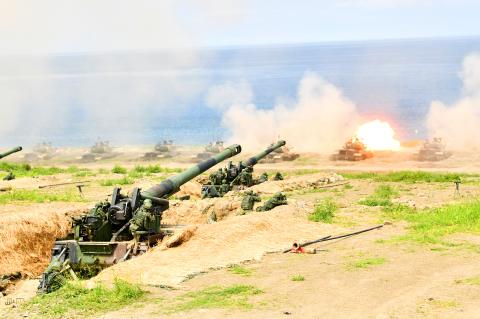All of the nation’s most cutting-edge weapons systems were yesterday featured in a large-scale anti-landing drill in Pingtung County that involved all branches of the military as part of the annual Han Kuang military exercises.
The air-sea drill began at about 9am, simulating a sea invasion by China’s People’s Liberation Army with air support.
The military deployed F-16 jets and Indigenous Defense Fighters, Knox-class frigates and the Thunderbolt-2000 — a new multiple-launch rocket system — to deter the invading force.

Photo: Tsai Tsung-hsien, Taipei Times
AH-1W Cobra and AH-64E Apache attack helicopters, and CM11, CM22 and eight-wheeled CM-34 Clouded Leopard armored vehicles were also deployed.
The first appearance of the CM-34 was a highlight, as it passed testing in October last year before entering mass production.
A total of 284 of the vehicles are expected to be made in the next few years.

Photo: Tsai Tsung-hsien, Taipei Times
A military official previously said that the CM-34 has a 30mm cannon with a range of 2km, better anti-tank capabilities than the CM-32 and can fire several rounds in rapid succession.
Another highlight was a demonstration by a squad of nine female military personnel, who fired M110 203mm self-propelled guns.
The squad leader told reporters that she was extremely proud to take part in the drill.
Yesterday’s drill was meant to test the military’s asymmetric warfare capabilities due to the growing military threat from China, the Ministry of National Defense said in a statement.
Over the past few decades, Taiwan’s armed forces focused on beach landings, but that emphasis has now been broadened, because China has been developing expeditionary warfare and over-the-horizon amphibious assault capabilities that pose a threat all along Taiwan’s coastline, a source said.
The strategy shift means that the military would put greater emphasis on boosting the defensive capabilities of the air force and navy rather than making the army the priority, the source said.
The annual Han Kuang exercises are held in two stages. The first comprises computerized war simulations, while the second is a five-day live-fire exercise held around the nation.
The 35th edition of the annual drill, involving 3,000 personnel, began on Monday and ends today.

The Ministry of Education (MOE) is to launch a new program to encourage international students to stay in Taiwan and explore job opportunities here after graduation, Deputy Minister of Education Yeh Ping-cheng (葉丙成) said on Friday. The government would provide full scholarships for international students to further their studies for two years in Taiwan, so those who want to pursue a master’s degree can consider applying for the program, he said. The fields included are science, technology, engineering, mathematics, semiconductors and finance, Yeh added. The program, called “Intense 2+2,” would also assist international students who completed the two years of further studies in

Former president Tsai Ing-wen (蔡英文) departed for Europe on Friday night, with planned stops in Lithuania and Denmark. Tsai arrived at Taiwan Taoyuan International Airport on Friday night, but did not speak to reporters before departing. Tsai wrote on social media later that the purpose of the trip was to reaffirm the commitment of Taiwanese to working with democratic allies to promote regional security and stability, upholding freedom and democracy, and defending their homeland. She also expressed hope that through joint efforts, Taiwan and Europe would continue to be partners building up economic resilience on the global stage. The former president was to first

Former president Tsai Ing-wen (蔡英文) on Monday called for greater cooperation between Taiwan, Lithuania and the EU to counter threats to information security, including attacks on undersea cables and other critical infrastructure. In a speech at Vilnius University in the Lithuanian capital, Tsai highlighted recent incidents in which vital undersea cables — essential for cross-border data transmission — were severed in the Taiwan Strait and the Baltic Sea over the past year. Taiwanese authorities suspect Chinese sabotage in the incidents near Taiwan’s waters, while EU leaders have said Russia is the likely culprit behind similar breaches in the Baltic. “Taiwan and our European

The Taipei District Court sentenced babysitters Liu Tsai-hsuan (劉彩萱) and Liu Jou-lin (劉若琳) to life and 18 years in prison respectively today for causing the death of a one-year-old boy in December 2023. The Taipei District Prosecutors’ Office said that Liu Tsai-hsuan was entrusted with the care of a one-year-old boy, nicknamed Kai Kai (剴剴), in August 2023 by the Child Welfare League Foundation. From Sept. 1 to Dec. 23 that year, she and her sister Liu Jou-lin allegedly committed acts of abuse against the boy, who was rushed to the hospital with severe injuries on Dec. 24, 2023, but did not